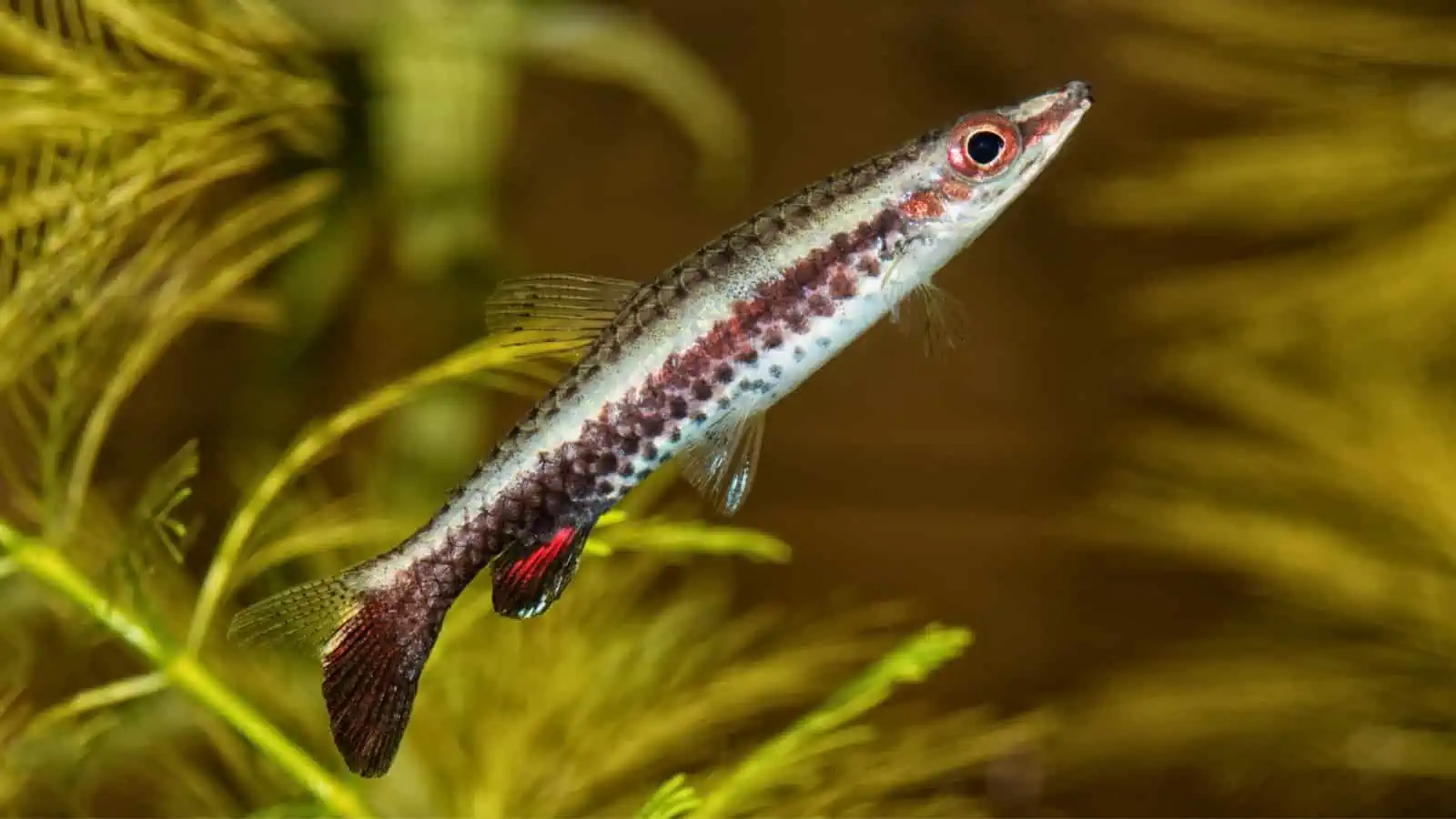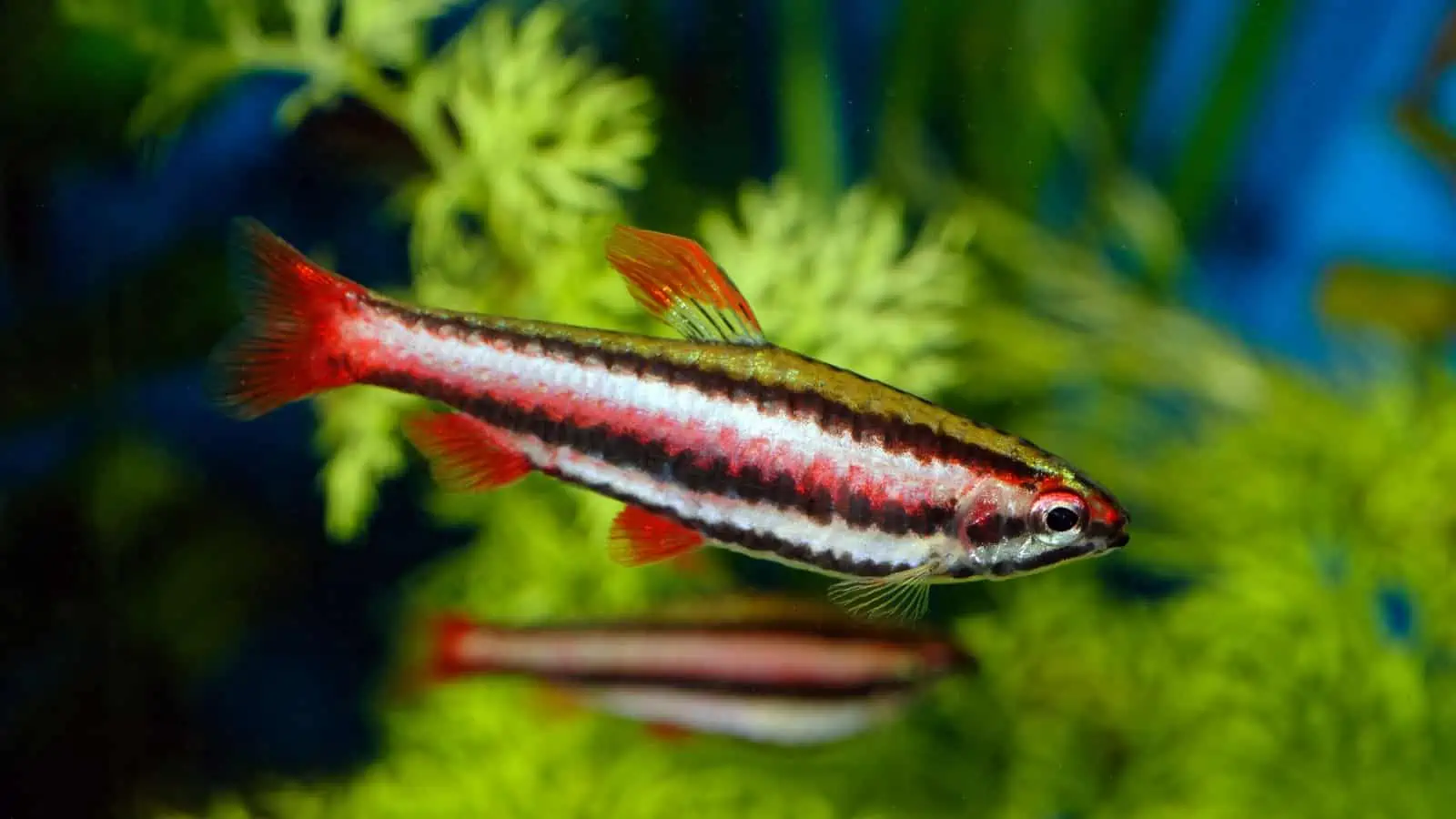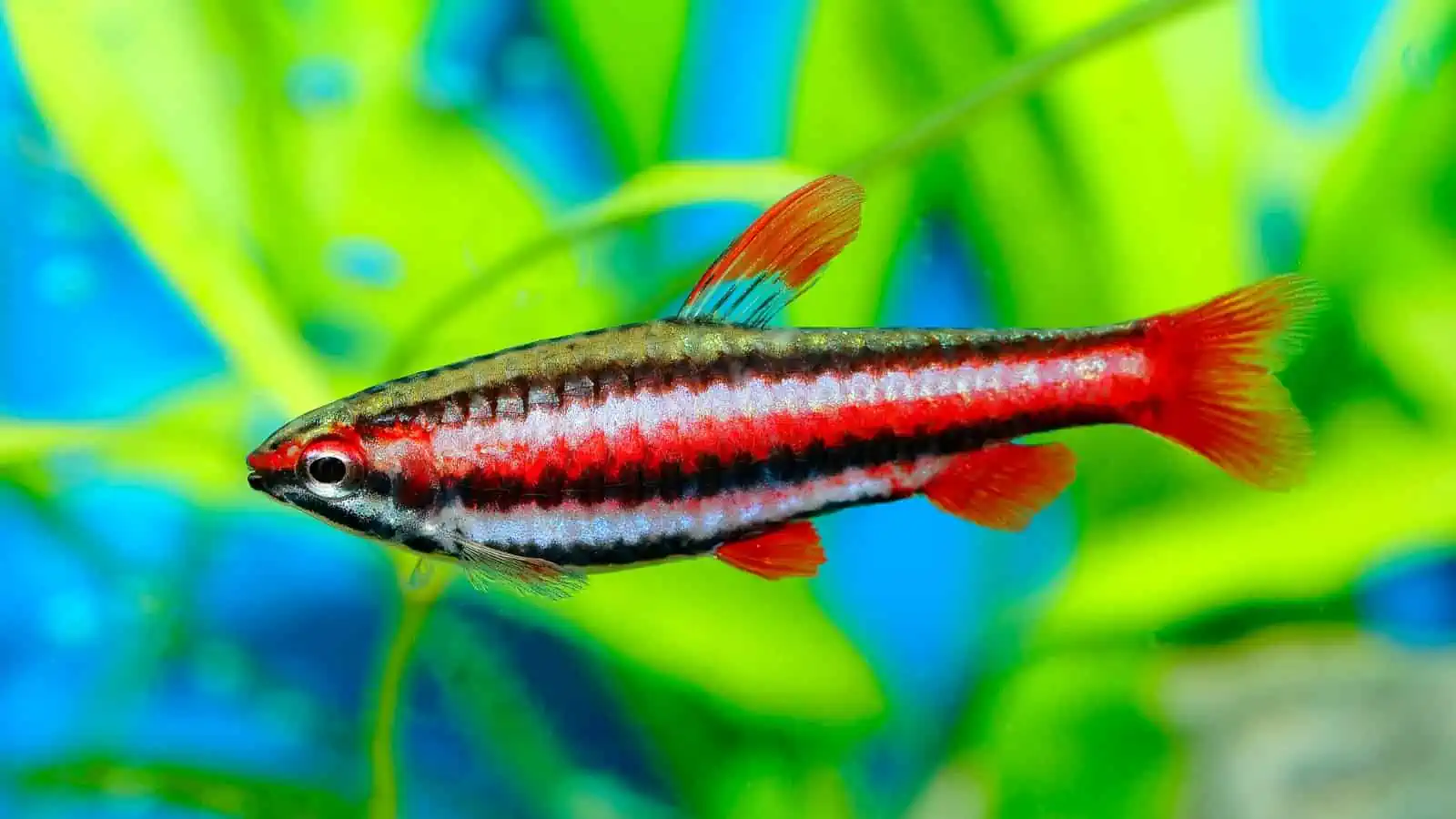[ad_1]
What if I told you that there’s a family of beautiful community fish, closely related to tetras, but rarely kept, even by advanced fish keepers?
Introducing the pencilfish – a fish tribe that’s largely overlooked, yet brimming with potential for freshwater community tanks.
In this guide, we’ll explore the most commonly kept species, and learn about the best ways to keep these peaceful fish happy, as a highlight of your aquarium.
Types of Pencilfish
There are 19 species of pencilfish in the wild, but only a few types are commonly seen in the aquarium trade. Let’s focus on 4 of the most popular types that you’re likely to see in aquarium stores.
Golden Pencilfish (Aka. Beckford’s Pencilfish)
| Golden Pencilfish Info | |
|---|---|
| Scientific Names | Nannostomus beckfordi, Nannostomus anomalus, Nannostomus simplex |
| Origin | Swamps and slow-flowing rivers in Brazil, French Guiana, Guyana, and Suriname. |
| Maximum Size | 1.5 – 2 Inches |
| Temperature | 70 – 80°F |
| Water pH | 5.5 – 8 |
| Care Level | Easy |
The golden pencilfish is the most popular pet pencilfish in the world. Growing to between 1.5-2 inches long, these small schooling fish are a great alternative to tetras.
One of the reasons that golden pencilfish have become so popular is that they’re easier than other species to breed in captivity. Because most aquarium stocks are captive-bred, they’re cheaper and hardier than most types that are caught in the wild.
While many pencilfish can be fussier with water chemistry and temperature, golden pencilfish will tolerate a pH anywhere between 5.5 – 8 and water temperatures between 70-80°F.
These peaceful dither fish make an excellent addition to peaceful dwarf cichlid tanks, helping shy species like Apistogrammas and keyhole cichlids to feel safe enough to swim out into open water.
Note that this species has sometimes been confused with its larger cousin Nannostomus grandis which grows to 2.5 inches long.
Diptail Pencilfish (Aka. Hockeystick Pencilfish)

| Diptail Pencilfish Info | |
|---|---|
| Scientific Names | Nannostomus eques, Poecilobrycon auratus, P. eques |
| Origin | Brazil and Peru |
| Maximum Size | 2 Inches+ |
| Temperature | 73-82°F |
| Water pH | 4.5 – 7.5 |
| Care Level | Intermediate |
One of the most fascinating of all pencilfish is the diptail or hockey stick pencilfish.
These quirky fish earn their name from their habit of swimming at a 45-degree angle with their head held high and their tail dipped low.
Their colors can differ depending on their precise regional origin, but they always have long thin bodies with dark and light stripes running from their nose to their tails. Some variants also have bright red fins and these will become brighter when they’re kept in ideal condition.
The diptail pencilfish is the only other species that are most commonly bred in captivity rather than being wild-caught, which helps them to remain hardy and affordable.
Dwarf Pencilfish

| Dwarf Pencilfish Info | |
|---|---|
| Scientific Names | Nannostomus marginatus, Nannostomus marginatus picturatus |
| Origin | Brazil, Colombia, Guyana, Peru, and Suriname. |
| Maximum Size | 0.7-1 Inches |
| Temperature | 75-80°F |
| Water pH | 4-6 |
| Care Level | Intermediate – Advanced |
Now, one of the smallest aquarium fish you can keep! The Dwarf Pencilfish usually only grows to between 0.7 – 1 inches long, making them a similar size to ember tetra.
Because of their tiny size, the dwarf pencilfish needs to be kept in a tank with plenty of hiding places and only the most peaceful tank mates. Small tetra, rasboras, and corydoras catfish make good matches.
As a species that’s mostly wild-caught, dwarf pencil fish are more fussy regarding water parameters than our first two species. A pH between 4-6 and a water temperature between 75-80°F is ideal.
Because they have especially tiny mouths, dwarf pencilfish can only be fed on the smallest foods such as baby brine shrimp, daphnia, and small particle flake food. Pellets and granules are not an option.
Coral Red Pencilfish
| Coral Red Pencilfish Info | |
|---|---|
| Scientific Names | Nannostomus mortenthaleri, Nannostomus marginatus mortenthaleri |
| Origin | Peru |
| Maximum Size | 1.5 Inches |
| Temperature | 75-82°F |
| Water pH | 5-7 |
| Care Level | Intermediate – Advanced |
At its best, the coral red pencilfish can be one of the most colorful and attractive members of the pencilfish family.
Males are significantly brighter than females, and at breeding time develop a heavy red hue throughout the body. Two thick black stripes also run from nose to tail.
The coral red pencil fish fetches some of the highest prices for any small schooling fish because their wild range in Peru is extremely limited. Now they’re being bred in captivity more often, but they still regularly fetch $15 per fish.
Because these fish are usually wild-caught, they prefer a diet that includes some live or frozen foods. Their close cousin Nannostomus rubrocaudatus, the Purple Pencilfish is also very colorful, usually wild-caught, and often even more expensive than this species!
Rarer Species of Pencilfish and Misidentification
Other pencilfish that are sometimes kept in the hobby include Nannostomus trifasciatus (the three-lined pencilfish), Nannostomus unifasciatus (One-lined pencilfish), and Nannostomus eques (Brown pencilfish).
Because these are less commonly kept, there is conflicting information available about their maximum size, temperament, and other characteristics. For example, some reports say the three-lined pencilfish only grows to 1.5 inches and is very peaceful, while others claim it’s a bully, growing to 2.5 inches long!
Much of the conflicting information is probably due to the misidentification of the species in the first place. Even scientists are still clarifying the different species within this genus!
Proceed with caution if you choose to keep these less common species. Ask questions and do your own research rather than simply trusting the species labels in fish stores.
Pencilfish Care Guide
A guide to keeping these timid schooling fish at their best.
Minimum School Size
Pencilfish are sociable, schooling fish that need to live in sufficiently large numbers to feel safe and secure. Furthermore, they look wonderful when kept in larger groups.
Keeping them in smaller numbers may lead to excessive fighting, especially between males.
I’d advise keeping pencilfish in groups of at least 6, with 8+ being even better.
Tank Size
Because pencilfish can be territorial and need to be kept in substantial schools, they should never be kept in tanks smaller than 20 gallons.
A tank of at least 30 gallons with plenty of hiding places is a much better setup for a long-term healthy and harmonious environment.
Tank Environment
Pencilfish will be happiest when you replicate their natural habitat within your fish tank. Check out this video to get a good idea of the wild habitat they reside in The Amazon Basin.
Plants and Decor
Because they come from densely vegetated wild habitats, pencilfish need the same type of conditions in the aquarium to feel at home.
Java fern, Java moss, Amazon Sword, Anacharis, Anubias, Crypts, and Vallisneria are all easy plants that can be grown by amateur aquarists without much experience.
Floating plants are also recommended – please see the lighting subheading below!
Because pencilfish swim in the middle to upper layers of the water column, they’re unlikely to use rocky caves, but pieces of driftwood are both beautiful and also break the aquarium up into smaller territories, helping males to live harmoniously.
Tannins
While captive-bred pencilfish are more adaptable to a wide range of water conditions, wild-caught specimens often come from blackwater regions and need soft, acidic water to thrive.
These habitats are known as ‘black water’ because the water is stained a dark amber color from the presence of dissolved tannins. Tannins are released from materials such as driftwood, fallen tree leaves, and peat and turn the water softer and more acidic.
By adding Indian almond leaves, aquarium-safe peat, or untreated hardwood such as beech and oak to the tank, tannins are released, imbuing the water with an amber hue while tipping the water chemistry in favor of these ‘black water fish’.
Important tip!: If you do wish to create a black water aquarium, you’ll need to remove your carbon filter, to prevent it from removing the tannins from the water.
Substrate
Most pencilfish come from rivers and swamps with a dark substrate that absorbs most light. Keeping them in an aquarium with a similarly dark substrate is often recommended to help them feel at home.
Lighting
Because the dark waters and overhanging trees of their native habitat allow less light to penetrate the water, pencilfish are adapted to fairly subdued lighting conditions.
The ideal balance is to provide enough lighting to stimulate sufficient plant growth yet not overwhelm your fish.
An elegant solution is to incorporate Floating plants like Amazon frogbit, Salvinia, and water sprite that create a dappled shading effect underneath.
Use a timer switch to give your tank 9-10 hours of light per day.
Tank Lid
Pencilfish aren’t the most active or athletic fish, but they have still been known for jumping out of fish tanks from time to time! Keeping a tight-fitting aquarium lid without any gaps, therefore, is essential.
Water Temperature
The exact water temperature range for pencilfish depends on the species and is listed in the species tables above.
To generalize, though, all common types of pencilfish will do well between 75-80°F, which makes them perfectly compatible with most other tropical fish.
Take note that pencilfish are known to be especially sensitive to sudden changes in water temperature, so acclimatizing them properly in a new tank and avoiding temperature fluctuations is essential to avoid thermal shock.
Water Parameters
As we’ve discussed, pencilfish come from soft acidic waters, so wild-caught specimens need these conditions replicated in the aquarium.
Captive-bred fish are less fussy and tend to tolerate a pH up to around 7.5, but all species are highly sensitive to sudden changes in pH levels – another reason that larger tanks are beneficial.
Always be sure to find out where your fish came from to determine the necessary pH to keep them happy.
Filtration
As with keeping any fish, an efficient aquarium filter is essential to keep water quality high. However, pencilfish are highly sensitive to strong currents, so strong filter flow must be avoided.
For 20-gallon tanks, you could install a couple of sponge filters, which are inexpensive, provide plentiful oxygen, and only create a gentle flow.
Hang-on-back filters and internal power filters are good options for tanks of 30 gallons and larger, but you must take measures to avoid overwhelming the fish with a strong flow.
Some filters allow you to manually adjust the flow rate. On other models, you can reduce the water current by using an aquarium spray bar, or lily pipe.
Feeding
Perhaps the most important care aspect to get right with pencilfish is feeding.
Because pencilfish have such small mouths, they’re very particular about what kinds of food they can eat. While small pieces of flake food will be accepted, even the smallest granules and pellets are often too large for these fish to swallow.
Additionally, wild-caught pencilfish will be unfamiliar with commercial fish foods and may not recognize or digest them particularly well to begin with.
Whether captive-bred or wild-caught, pencilfish are naturally carnivorous and will do best when given plentiful helpings of small fresh and frozen foods such as daphnia, brine shrimp, mosquito larvae, and microworms. Larger species will also accept bloodworms and tubifex worms.
Keep a close eye on how much each fish is eating at feeding time. While aggressive feeders like Golden Pencilfish may deprive other community fish of their share, the more timid Dwarf Pencilfish may struggle to get their fill in a competitive community tank setup.
Behavior and Tank Mates
Are Pencilfish Aggressive?

Pencilfish are generally known for being peaceful fish, but there are always exceptions to the rule!
Look through some online fish-keeping forums and you’ll soon find stories of aggressive male pencilfish that bullied or even killed some of their tank mates. In my opinion, however, these situations could have been avoided by creating a more suitable setup.
Like many other schooling fish, pencilfish will usually only become aggressive if they feel stressed, from not having enough space or hiding places. Given a large enough tank with plenty of plant cover, pencilfish will usually get along with one another and their tank mates without any issues.
What Is the Best Male: Female Ratio?
Male pencilfish are more aggressive than females, and part of the reason is competition between them to mate with females.
Even though pencilfish don’t always breed in captivity, the male’s instinct to attain dominance and win mating rights is still active. It’s sometimes recommended, therefore, to keep two females to every male if conflicts perpetually arise.
Compatible Tank Mates
When choosing tank mates for pencilfish, remember that they’re closely related to tetras. Most typical tetra tank mates will make good companions for them, too.
Rasboras, danios, and smaller tetras all make natural choices for fellow schooling fish. You could also include some smaller livebearers like guppies and endlers if your water chemistry will satisfy all species.
Pencilfish have also been suggested as the ideal ‘dither fish’ for shy cichlids. Because bottom-dwelling cichlids such as Apistogrammas and Kribensis are sometimes cautious about swimming in open water without the presence of other fish, a school of pencilfish will encourage them to come out more often.
Just be cautious of keeping pencilfish alongside boisterous tank mates of the middle and upper water layer fish like gouramis, bettas, and barbs. Pencilfish are not as agile or robust as some other community fish. Smaller species like the dwarf pencilfish are especially liable to getting bullied or eaten.
Health and Disease
Pencilfish are not particularly prone to diseases, but they remain susceptible to the same diseases and health conditions of other fish when tank conditions are poor or when they become stressed.
Ich, velvet, and flukes are all common parasitic diseases that can lie dormant in an aquarium for years until a weakened fish or very poor water quality offers them a chance to strike.
Similarly, bacterial and fungal infections like columnaris and water molds only tend to affect fish that are already vulnerable.
Keeping pencilfish in groups of 8 or more, with plenty of hiding places in a clean tank, is, therefore, the best defense against stress and unnecessary diseases.
Breeding
Pencilfish are not the easiest family to breed in aquariums and attempting breeding is best left to experienced hobbyists and professionals.
These egg scatterers are often difficult to coax into spawning, then will spawn slowly and eat their own eggs when given the chance.
Of all the species, the golden pencilfish is the easiest to breed.
If you’re serious about trying to reproduce this fish in captivity, I highly recommend watching this video. Starting at 11 minutes, the presenter outlines the best methods for breeding these tricky fish.
Lifespan
In captivity, pencilfish usually live for around 5 years.
When kept in ideal conditions, even longer lifespans are possible.
For them to reach their maximum lifespan, their diet, water conditions, and quality of care must be of the highest order.
Tank Maintenance
Some top tips for keeping your pencilfish in tip-top condition!
- Install a good filter and clean it every 2-3 weeks.
- Vacuum your substrate and make partial water changes of 15-35% every 1-2 weeks with treated water of matching temperature.
- Get yourself a reliable heater and thermometer. Make daily checks to ensure the temperature is within a stable range for all of your fish.
- Observe your fish closely every day to ensure they are in good health and interacting peacefully with each other.
- Test your aquarium’s water at least once a month or any time your fish seem unwell. Keep nitrates below 20 ppm.
Final Thoughts
Pencilfish are an underrated community fish that can bring a lot of interest and something novel to your fish tank.
While many species are wild-caught and are more difficult to keep, golden pencilfish and even dip-tailed pencilfish are usually captive-bred and are hardy enough even for diligent beginners to try.
If you’re looking for the ultimate tank mate for pencilfish, be sure to check out our care guide to ember tetra, here.
[ad_2]
Source link
